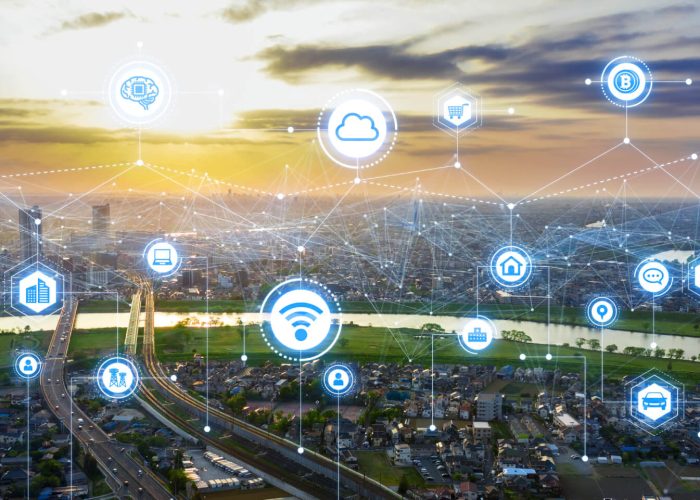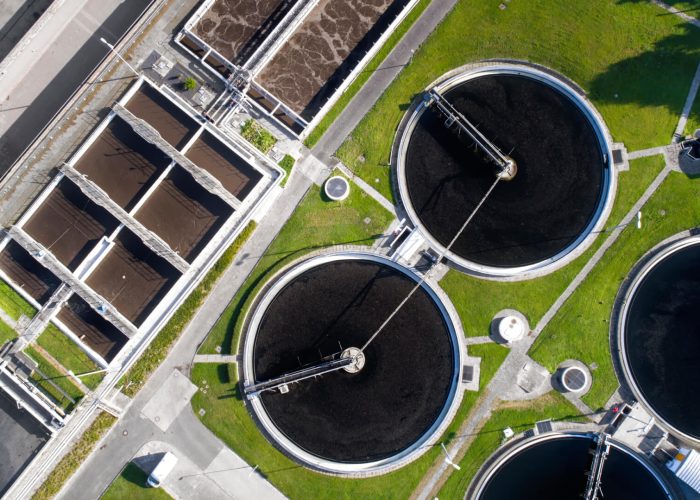Building Smart Cities: An Introduction
Today, cities across the United States are growing and changing rapidly. It is estimated that 83% of the U.S. population lives in urban areas, which is expected to increase to 89% by 2050. To best meet the needs of this growth and prevent strains on infrastructure, cities are focusing on providing enhanced security, efficiency, and environmental stewardship and looking holistically at becoming more resilient.
In this guide, I’ll outline the key characteristics leaders should know when undertaking infrastructure solutions. These same concepts can apply to college campuses and school districts.
Understanding Smart Cities
Defining “Smart”
So, what is a smart city or smart campus? Many cities and school districts have already implemented “smart” technologies. For example, schools have implemented free Wi-Fi for students who couldn’t attend in person during the pandemic.
Recently, the term has been a catch-all buzzword to describe technology-driven enhancements that provide real-time analytics to increase operational efficiency and share information. More specifically, Dr. Jonathan Reichental, author of Smart Cities for Dummies, maintains that “a smart city uses innovative technologies to enhance community services and economic opportunities, improve city infrastructure, reduce costs and resource consumption, and increase civic engagement.”
For example, some cities implement broadband through networked LED streetlights. Others implement Advanced Metering Infrastructure (AMI) and Supervisory Control and Data Acquisition (SCADA) solutions to improve water utility efficiency, detect leaks, and reduce unbilled water. Moreover, these improvements don’t just benefit cities. They can also positively impact local citizens. In the case of AMI and SCADA solutions, residents can access their water usage data in real-time, set alerts, and monitor their usage to reduce water consumption and, ultimately, their water bill.
Critical Components of Building a Smart City
Many components fall under the umbrella of smart city infrastructure. When used singularly or in conjunction with multiple initiatives, improvements can significantly enhance operational efficiencies and the quality of life for residents. There is no one model for a smart city, but key aspects of building smart cities include the following:
- Stakeholder Engagement: It is crucial to the success of large-scale infrastructure projects. Citizens, parents and students need to be aware of and prepared for any changes. When citizens and local governments work together, positive community changes are possible.
- Infrastructure: Improving the efficiency and capabilities of government services is key to preparing for and maintaining sustainable growth. Critical infrastructure services include city-wide facility management, wastewater treatment, and water distribution.
- Broadband: The internet has become an essential service – like electricity. As a result, there is a critical need for information communication technology and public Wi-Fi. High-speed internet connections allow for economic development and the growing remote work trend.
- Public Safety: In terms of technology, many tools can help sense, analyze, and act on potential public safety threats. For example, smart cameras can detect accidents and call for EMS and microphones can identify gunshots, triangulate a shooter’s location, and relay that information to the closest first responder.
- Resiliency: Cities must be resilient to any challenge they may face, particularly concerning critical infrastructure services that citizens rely on. If faced with rising water, inclement weather, or extreme conditions, technologies like renewable energy, smart grids, centralized building automation, communication redundancy, and asset efficiency can help cities avoid critical failures. Water utilities can use drone technology for leak detection.
- Energy Efficiency: Increasing energy efficiency is good for the environment and for a city’s bottom line. Connected buildings, LED lighting upgrades, smart street lighting, building envelope improvements, HVAC equipment upgrades, and energy dashboards can benefit public budgets through increased income and decreased operating expenses.
- Healthier Communities: Most cities share the goal of enabling healthcare access for all and nurturing the social, economic, and environmental factors contributing to residents’ overall well-being. Telemedicine opportunities for homebound individuals are an excellent example of how digitized cities can better serve citizens.
- Transportation: Enabling intelligent transportation systems or using traffic management centers is vital for cities’ growth. For example, traffic management centers can monitor and coordinate large networks of sensors to improve traffic congestion.
- Data Analytics: Access to better data management and an understanding of the 3 Vs (volume, velocity, and variety) will enable cities to make better, faster decisions. With actionable data insights, policymakers can improve operations, reduce resource consumption, monitor security risks, and better manage budgets.
- Artificial Intelligence: AI can be used to identify and troubleshoot problems through connected infrastructure and much more. AI will play a positive role in most, if not all, future smart projects.
Benefits of Smart Cities
The benefits of smart city technology extend far beyond technological advancements, encompassing improved quality of life, sustainability, and economic growth, ultimately creating more vibrant, efficient, and livable urban areas. The top nine benefits of smart city projects include:
- Improved Quality of Life: Smart cities prioritize the well-being of residents by enhancing public services, healthcare, education, and safety, resulting in an overall higher quality of life.
- Sustainable Urban Planning: Smart cities focus on sustainable practices, including energy-efficient infrastructure, green spaces, and reduced environmental impact, promoting long-term environmental health.
- Operational Cost Savings: Smart technologies help cities cut operational costs by reducing energy consumption, minimizing waste, and improving resource allocation, ultimately saving taxpayers’ money.
- Attracting Investment and Talent: Adopting innovative technology attracts businesses, entrepreneurs, and skilled professionals, stimulating economic growth and job opportunities.
- Data-Driven Decision-Making: Smart cities leverage data analytics to make informed decisions, leading to better resource allocation, improved public safety, and more effective urban planning.
- Safety and Security: Smart cities employ advanced technologies, such as surveillance cameras and predictive policing, to enhance public safety and reduce crime rates.
- Environmental Benefits: Smart cities reduce carbon emissions through initiatives like renewable energy integration, efficient waste management, and sustainable transportation, mitigating the impact of climate change.
- Resilience: Smart cities are better equipped to respond to natural disasters and emergencies with advanced early warning systems and improved disaster management protocols.
- Tourism and Cultural Attraction: Smart cities can enhance tourism experiences by providing digital guides, interactive exhibits, and cultural preservation efforts, attracting more visitors.
Why Implement These Technologies Now?
The United States’ Infrastructure is in bad shape. According to the American Society of Civil Engineers’ 2021 report card for America’s infrastructure, the U.S. scores an overall C-. Cities and towns are in dire need of infrastructure repair. To reiterate this point, the report card states, “an estimated 6 billion gallons of treated water is lost each day, the equivalent of over 9,000 swimming pools,” and “the growing wear and tear of roads has left 43% of public roadways in poor or mediocre condition.” These statistics highlight the importance of acting now.
In addition to deteriorating infrastructure, rapid urban population growth, environmental concerns, and resource scarcity demand that cities adapt to changing needs or fear of being left behind.
Examples of Smart City Technology
When designing sustainable urban developments with smart city solutions, city leaders should consider infrastructure improvements that reduce energy consumption and save on maintenance and operation costs. It’s good for both the environment and the community. Plus, these smart infrastructure updates make your city or town more resilient without the need for much, if any, upfront capital (details how below). Key energy conservation measures and infrastructure improvements to consider when smart city planning include:
- Smart Energy Grids: Integrating renewable energy like solar panels into the grid reduces carbon emissions and enhances energy resilience. Additionally, consider energy consumption monitoring. Deploying modern meters and demand response systems to help residents and businesses better manage their energy usage, especially during peak times. Additionally, microgrids offer the following benefits:
- Reduced Utility Costs: Microgrids effectively manage electricity demand, alleviating grid congestion and lowering utility costs.
- Enhanced System Reliability: Microgrids ensure uninterrupted power supply, even in the face of extreme weather conditions.
- Resilience for All: Microgrids guarantee consistent and reliable power, especially for communities located on the outskirts of the larger grid.
- Business Intelligence Advantage: The consolidation of data and insights into a single, integrated platform empowers cities with real-time visibility and the ability to proactively manage energy resources, resulting in more informed decision-making.
- Smart Water Management: Various smart water solutions help cities and towns save money while improving water services. Smart water meters and Advanced Metering Infrastructures (AMI) provide better and more accurate water data, water revenue optimization, remote control features, leak detection, and more. Drones can be used for aerial water system leak detection. Further, wastewater treatment plant upgrades should be considered to increase efficiency and decrease operating costs.
- Networked LED Streetlights: Smart streetlights are designed to be the foundational component of smart city management as they create a framework for narrowband and broadband communications. They are equipped with sensors, wireless connectivity, and advanced technologies, allowing them to interact intelligently with their surroundings. These sensors can monitor everything from air quality and noise levels to traffic flow and pedestrian movement. With this data, city officials can make informed decisions to improve the overall efficiency and livability of the city.
- Environmental Sensors: Deploying sensors to monitor pollution levels, noise, air quality, and weather conditions allows city leaders to better manage environmental resources and provide real-time information to residents. These sensors can be integrated with the networked streetlights mentioned above.
- Wi-Fi Connectivity: Providing free or affordable access to public areas promotes digital inclusion and enhanced connectivity for other smart technologies, like digital exhibits.
- Public Safety Enhancements: Installing surveillance cameras with AI-powered analytics helps detect potential safety risks or emergencies. Such information can be shared with law enforcement agencies or emergency responders, allowing quicker response times and improved public safety.
- Smart Waste Management: Efficient collection and recycling optimize waste collection routes and schedules through IoT sensors and data analysis. Better waste sorting technologies can automate processes to improve recycling rates.
- Smart Transportation Systems: A few solutions exist to improve city transit. Implementing real-time traffic monitoring and adaptive signal control reduces traffic congestion. In terms of public transportation, investing in smart fare collection systems, real-time transit tracking, and digital signage improves the rider’s experience. Lastly, with the expected surge in all-electric vehicle (EV) ownership, cities should increase charging station availability to make charging easy, accessible, and equitable.
Wondering how your city or town stacks up? Our engineers are here to help evaluate your systems and develop a report card for your city. Get in touch with us for a facility assessment.
Smart City Planning and Implementation
Assessing Current City Infrastructure and Needs
When pitching a smart city initiative, you need to build a strong case, and that all starts with understanding the costs and the benefits. So, when you’re thinking about the price tag of turning your city smart, consider a few things. First, consider your city’s priorities, both now and in the future. Think about how old your current systems and equipment are, how well they’re working, and what it costs to keep them running. Check if your staff can handle these systems and their maintenance and consider potential savings in energy and operations. You can even explore funding options, like energy savings contracts or American Rescue Funds, which might offset some initial costs (more details on funding included below). Also, don’t forget to calculate not just the initial cost but the total cost of the project and the payback it’ll deliver in the end. And remember, while estimating these costs, consider what it could cost you if you wait. Even if your systems are okay now, what happens in a crisis if they fail?
Developing a Smart City Plan
Developing a smart city plan or roadmap requires a holistic approach balancing technology, community needs, governance, and financial sustainability. To get started, city leaders can take the following steps:
1. Assessment and Objectives:
Begin by thoroughly assessing your city’s current infrastructure, challenges, and future growth projections. Identify specific areas where smart technology can have a significant positive impact, such as transportation, energy, healthcare, public safety, or environmental sustainability. Then, clearly define objectives. Ensure that these objectives align with your city’s overarching vision and mission. For example, a SMART objective could be reducing traffic congestion by 20% within three years by implementing smart transportation solutions.
2. Stakeholder Engagement:
Engage key stakeholders, including residents, local businesses, government departments, technology experts, and community organizations. Seek input from diverse perspectives and backgrounds to ensure the roadmap addresses various population segments’ unique needs and concerns. This input can be gathered through public meetings, surveys, focus groups, and consultations.
3. Technology Evaluation:
Research and evaluate available smart technologies that align with the identified objectives. Consider the latest innovations in the field, their compatibility with existing systems, and their scalability to accommodate future growth. Evaluate potential technology partners and vendors for their expertise and reliability in delivering solutions.
4. Data Management and Compliance:
Develop comprehensive policies and strategies for data collection, storage, utilization, and sharing. Address data privacy and security concerns, ensuring all activities comply with relevant local, state, and federal regulations, industry standards, and best practices.
5. Financial Planning:
Create a detailed budget outlining the costs of implementing smart technology solutions. This should encompass hardware, software, labor, and any associated infrastructure changes. Explore various funding sources, such as government grants, public-private partnerships, energy savings contracts, and other financing options to support the initiatives. Investigate potential grants at Infrastructure Investment and Jobs Act (IIJA) Implementation Resources (gfoa.org)
6. Prioritize and Pilot:
Prioritize projects based on their potential impact, feasibility, and alignment with the objectives. Plan for a phased approach to implementation, starting with smaller-scale pilot projects to test and validate technologies before moving on to full-scale deployment.
7. Adaptation and Maintenance:
Establish a system for ongoing adaptation and feedback collection, ensuring the roadmap remains flexible and responsive to changing circumstances, emerging technologies, and lessons learned from pilot projects. Continuously engage with the community to address feedback and concerns, informing residents about progress and outcomes. Develop a long-term maintenance plan to ensure the sustainability and innovation of smart technologies, keeping the city at the forefront of technological advancements.
Selecting a Qualified Partner
Developing a roadmap may seem complex, but selecting an experienced partner can help. Selecting the right infrastructure provider can make the transition smooth and cost-effective. The best approach is to engage with a licensed, NAESCO-accredited ESCO (energy services company) with a track record of successful projects. They offer sole accountability through a design-build approach, meaning your city or school can rest assured that the project will be handled from design through to implementation with one contact. They serve as a one-stop shop and will ensure single-source accountability through a single contract. This safeguards against multiple contracts and the inevitable finger-pointing from managing separate contractors.
Funding Smart City Improvements with Budget-Neutral Financing
City officials know that for each project they take on, there is a financing obstacle to overcome. What many cities and towns may not know is that budget-neutral financing for energy-focused smart city technology is possible in most states. With state-enabled legislation, like energy savings performance contracts, smart infrastructure projects can be implemented with little to no upfront capital. The project is financed and repaid with guaranteed energy and efficiency savings from the smart improvements. Once the project is completed, the qualified ESCO monitors utility bills and energy consumption to ensure everything runs correctly and efficiently. With Performance Services, you can rest assured that if the actual savings do not match the promised savings, we will repay the difference and make any changes needed. All additional savings stay with the city.
Additionally, federal aid from the American Rescue Plan Act (ARPA) and the Infrastructure Investment and Jobs Act (IIJA) may be available to implement these solutions. A qualified partner can help determine what your project may be eligible to receive. Infrastructure Investment and Jobs Act (IIJA) Implementation Resources (gfoa.org)
Case Study: A Successful Smart City Project Focused on Water Management
The City of Jacksonville, Texas, was experiencing issues from aged water meters and inefficient metering processes. In 2018, the City decided to implement smart water technology to improve its processes, improve customer services, and reduce operations and maintenance costs. As a result, the City of Jacksonville implemented an energy savings performance contract to upgrade to smart water meters and an advanced metering infrastructure. Once implemented, the smart meters and AMI technology provided the City and residents with visibility into their water use with online monitoring tools.
A critical part of the infrastructure was the decision to add a radio-controlled auto-shut-off feature. This allowed the City to remotely shut off all residential meters in the event of a natural disaster. This feature proved invaluable during the Texas freeze in February 2021. When temperatures dropped below freezing, the City began auto-shutoffs to safeguard water lines. This action saved the City millions of gallons of potential water loss and prevented devastating damage to the water pipe infrastructure.
In 2021, as a result of this project, the Smart 50 Awards Program honored the City of Jacksonville’s AMI/smart city project as one of 50 projects globally for its innovation and community impact.
Conclusion
With strategic planning and commitment to innovation, local governments undertaking improvement projects in these areas will undoubtedly take a step toward becoming smarter cities and towns. Doing so should yield positive outcomes, not just in terms of growth, but will help provide sustainable economic development opportunities, improved government efficiencies, healthier environments, better traffic flow, increased safety, and upgraded infrastructure.
Are you interested in exploring smart infrastructure, and what steps you can take now to prepare for the future? Our team is here to help! We can evaluate your unique challenges and opportunities and provide planning for implementing critical improvements today to better prepare you and your citizens for tomorrow.
Hear From Satisfied Clients.









